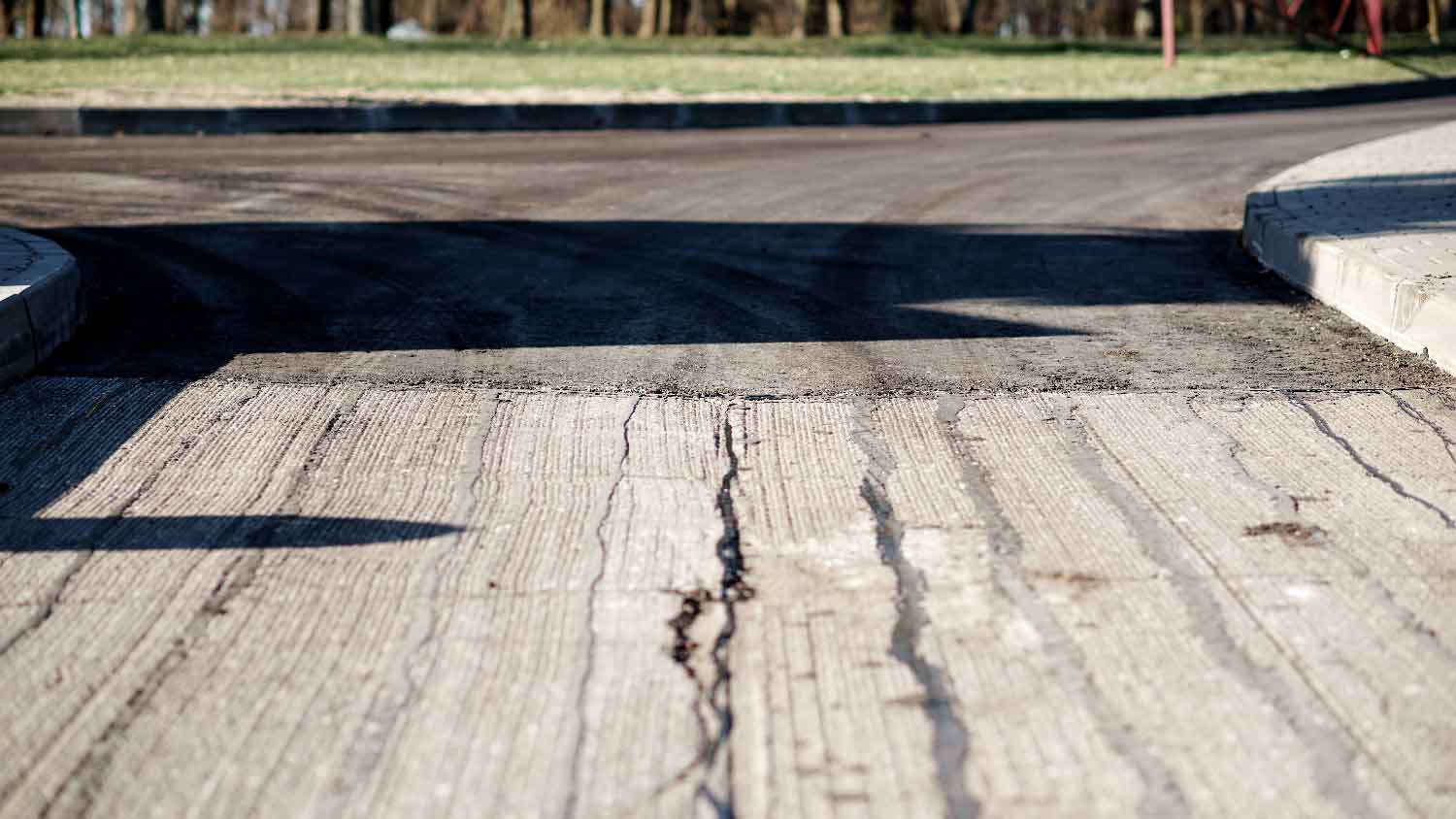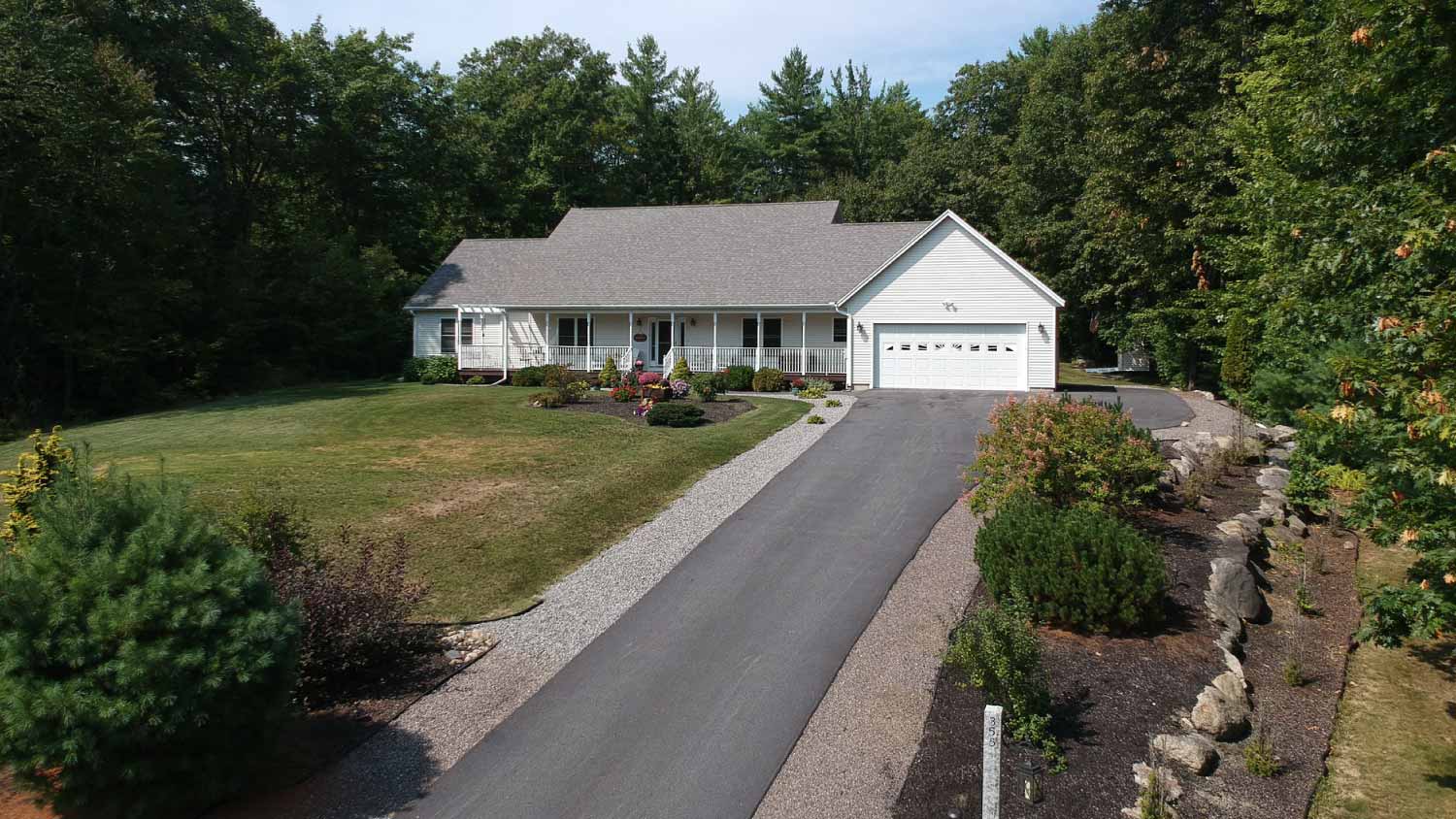How to Build a Gravel Driveway
Ride in style on your own gravel driveway


This project can be costly in more ways than one. Hire a pro to get the job done right the first time, avoid potential injury, and eliminate budget-breaking DIY mistakes.
- Shovel or sod cutter
- Backhoe
- Skid-steer loader or excavator (optional)
- Wheelbarrow or tractor
- 'Landscape stakes
- Gravel (three types: small, medium, large)
- Landscape fabric or geotextile barrier (optional)
- Landscape staples or heavy rocks
- Bricks, concrete pavers, timber, metal, or plastic edging (optional)
Gravel driveways are affordable, low-maintenance alternatives to asphalt or concrete, but proper installation makes all the difference. Without the right prep and execution, you could end up with shifting gravel, drainage issues, or ruts that turn into costly problems. This guide walks you through everything you need to know to build a gravel driveway that stays solid and looks great for years.
Plan the Driveway
Before you start the gravel driveway installation, plan ahead to prevent common issues like poor drainage, uneven surfaces, and insufficient gravel coverage.
Decide on the Location
Pick a spot that makes the most sense for your property. Straight driveways are typically the easiest and cheapest to install, but a curved driveway might work better if you’re dealing with obstacles like trees or steep slopes.
You should also think about how water will drain. In most cases, gravel driveways should slope slightly to the sides so water doesn’t pool in the middle. Also, if your driveway is on a hill, you might need additional drainage solutions like a French drain to prevent erosion.
Check for Permits
Before breaking ground, make sure to check with your local municipality to determine whether you need a permit to install the driveway. Some areas have zoning regulations, drainage requirements, or restrictions on materials. If you skip this step, you could run into fines or the need to relocate your driveway.
Decide on Dimensions
The best driveway size depends on how many vehicles will use it and whether you need extra space for parking or turning around. A single-car driveway should be at least 10 to 12 feet wide to accommodate most vehicles, while a two-car driveway should be 20 to 24 feet wide.
The right length depends on how far your driveway needs to extend from the road to your home or garage. If you have a detached garage or extra parking areas, factor those in when measuring. If your driveway has curves, add extra width to make turns easier and prevent vehicles from driving over the edges.
Calculate How Much Gravel You’ll Need
Driveways should typically have three layers of rock, each about four to six inches deep. This will ensure a stable foundation that prevents shifting and reduces the risk of ruts and potholes.
To determine how much gravel you need:
Multiply the length × width × depth of your driveway (converted to feet) to get the cubic feet required for each layer.
Divide the total by 27 to convert cubic feet to cubic yards (the standard measurement for gravel orders).
Order gravel in separate deliveries for each layer, allowing time for settling between applications.
Order the Gravel
Now that you’ve figured out exactly how much gravel you need, it’s time to order it. It’s best to have the gravel delivered in separate loads for each layer, spaced out by two to three days. This gives each layer time to settle before you add the next, making for a more stable driveway in the long run. Some delivery trucks can help spread the gravel or drop it in smaller piles along the driveway, which can save you some effort when it’s time to distribute it.
Mark the Driveway
Once you've planned out your driveway’s location, size, and drainage, it’s time to mark the area and prepare the ground. Start by marking the perimeter of your driveway using landscaping stakes and string or twine. This will give you a clear visual of where the driveway will go and help you confirm the dimensions before you start digging.
Place stakes along one side of the driveway every 8 to 10 feet.
Place a second set of stakes parallel to the first, spaced 10 to 12 feet apart for a single-car driveway or 20 to 24 feet apart for a two-car driveway.
Tie string or twine tightly between the stakes to create a clear outline.
Step back and check the layout. Now’s the time to make any adjustments.
If your driveway has curves, use a flexible garden hose or spray paint to create smooth, natural-looking lines before placing your stakes.
Clear the Area
Before you start laying gravel, remove any grass, topsoil, or debris from the staked area. Skipping this step can cause the driveway to shift over time. A shovel or sod cutter works well for smaller areas, but if you're dealing with a large space or rough terrain, renting a backhoe or skid-steer loader can make the job much faster. Be sure to clear out any large rocks, tree roots, or other obstructions that could interfere with grading to create a smooth, stable base for your driveway.
Excavate the Area
For a stable gravel driveway, you’ll need to dig out at least 12 to 18 inches of soil to make room for the gravel layers. A shovel works for smaller projects, but using a backhoe or excavator is the best option for larger areas. If your soil is particularly soft or prone to shifting, digging an extra 2 to 4 inches can help improve stability. Make sure the bottom of the excavation is as level as possible to prevent future sinking or uneven spots.
Grade and Compact the Surface
Grading the surface before you lay gravel is super important because it prevents standing water, which can erode the driveway and cause dents and other problems over time. Using a backhoe, mechanical compactor, or heavy-duty rake, create a level base while maintaining a slight slope—about 2% to 5%—toward the edges to help with drainage.
Once the surface is graded, compact the soil with a plate compactor or heavy roller to create a firm, stable foundation.
Install a Weed barrier (Optional)
Laying a weed barrier helps prevent grass and weeds from growing through the gravel, which can weaken the driveway over time and make your gravel driveway maintenance tougher. Use a durable landscape fabric or geotextile barrier to cover the entire excavated area, making sure it extends slightly beyond the driveway’s edges.
If you need multiple sheets, overlap them by six to twelve inches. Then, use landscape staples or heavy rocks to keep the fabric in place. Make sure it’s secure enough to withstand any extreme weather in your region.
Install Edging to Contain the Gravel (Optional)
Edging is another optional step, but it’s a very helpful one because it helps keep the gravel contained, preventing it from spreading into your yard. You can use a variety of different materials to create edging, including bricks, concrete pavers, timber, metal, or plastic landscape edging, depending on your needs.
Install the edging along the perimeter of the driveway, making sure it sits slightly above the final gravel level to keep everything in place. Depending on the type of edging you're working with, secure it firmly in the ground using stakes, rebar, or other anchoring materials.
Spread and Compact the Base Layer
 Photo: Noel / Adobe Stock
Photo: Noel / Adobe StockStart by spreading a layer of larger gravel, typically three to six inches in diameter, evenly across the driveway. You can use a shovel, wheelbarrow, or tractor to distribute the gravel—just make sure it covers the entire driveway area and is about four to six inches deep.
Once you evenly spread the gravel, use a mechanical compactor, plate compactor, or heavy roller to press the rocks firmly into place. This step is crucial because it prevents shifting, improves drainage, and ensures the driveway remains stable under the heavy weight of vehicles. You can also lightly spray the area with water to help settle the gravel before compacting.
Add the Middle Layer
The middle layer should consist of medium-sized gravel, typically two to three inches in diameter, which sort of locks together to create a strong foundation. Spread the gravel evenly across the entire driveway, making sure it’s four to six inches deep. Just like you did with the base layer, use a mechanical compactor or heavy roller to press it firmly into place.
Apply the Top Layer
The top layer is what you’ll see and drive on, so choosing the right material is important for both appearance and function. Crushed stone, pea gravel, or decorative gravel in sizes ranging from 1/2 inch to two inches in diameter work best for this final layer.
Spread the top layer evenly over the middle layer to a depth of four to six inches. Use a rake or shovel to smooth out the surface, then compact it one final time with a plate compactor or heavy roller. After you complete this step, your new gravel driveway is good to go!
DIY vs. Hiring a Pro
Building a gravel driveway yourself can save money, but it’s a physically demanding project that requires careful planning and the right equipment. The biggest DIY expenses come from materials and equipment rentals. Gravel costs around $65 per cubic yard, but you may also need to factor in the cost of renting an excavator and other equipment.
If you’re looking to save some money, already own the necessary tools, and don’t mind putting in some heavy labor, the DIY route might be a good fit for you. But mistakes like improper grading or poor drainage can lead to big problems that are expensive to fix, so make sure you’re comfortable with all of this project’s steps before taking it on yourself. If not, call a local driveway company to tackle it for you.
The timeline depends on the size of your driveway and whether you’re doing it yourself or hiring a pro. An experienced DIYer could take a weekend to complete a small, straight driveway, while a larger or more complex project could take a week or more. Hiring a pro speeds up the process since they have the right equipment and crew to usually get it done in a day or two.
A gravel driveway should have at least three layers, each using a different type of gravel. The base layer should comprise relatively large crushed stone, about three to six inches in diameter. The middle layer should consist of medium-sized gravel, about two to three inches in diameter, and the top layer should be made of smaller, crushed stone or pea gravel about 1/2 inch to two inches in diameter.
Regular maintenance involves raking or leveling out any displaced gravel, filling in low spots, and adding fresh gravel as needed to help prevent potholes and ruts. If you live in an area with heavy rain, checking the drainage and reinforcing the edges periodically can help prevent erosion.
When maintained properly, a gravel driveway can last 50 to 100 years or more. A rock base of at least four to six inches of gravel will last many decades, especially when you fill in holes and ruts and keep the surface grade in good condition. Keep your gravel driveway looking its best by starting with proper grading and leveling, adding gravel to pooling water spots, and resolving potholes quickly.














